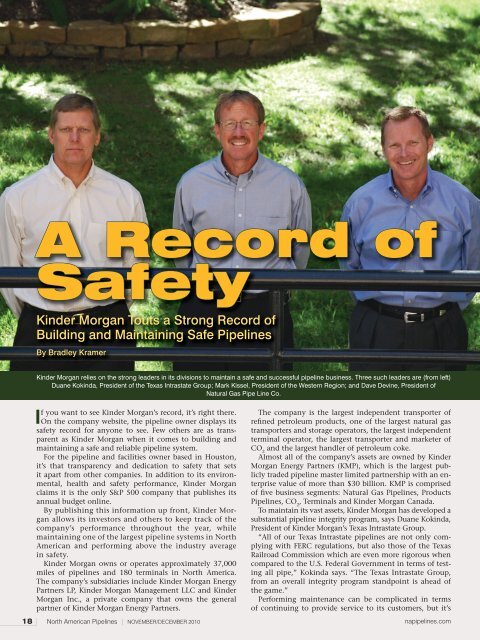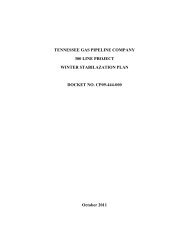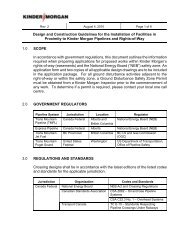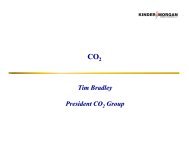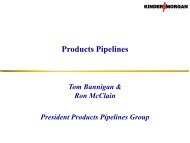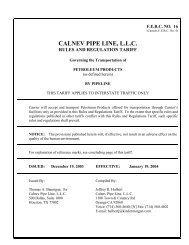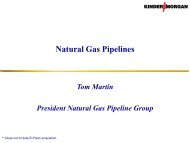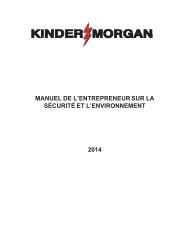PDF Article - Kinder Morgan
PDF Article - Kinder Morgan
PDF Article - Kinder Morgan
Create successful ePaper yourself
Turn your PDF publications into a flip-book with our unique Google optimized e-Paper software.
A Record of<br />
Safety<br />
<strong>Kinder</strong> <strong>Morgan</strong> Touts a Strong Record of<br />
Building and Maintaining Safe Pipelines<br />
By Bradley Kramer<br />
<strong>Kinder</strong> <strong>Morgan</strong> relies on the strong leaders in its divisions to maintain a safe and successful pipeline business. Three such leaders are (from left)<br />
Duane Kokinda, President of the Texas Intrastate Group; Mark Kissel, President of the Western Region; and Dave Devine, President of<br />
Natural Gas Pipe Line Co.<br />
If you want to see <strong>Kinder</strong> <strong>Morgan</strong>’s record, it’s right there.<br />
On the company website, the pipeline owner displays its<br />
safety record for anyone to see. Few others are as transparent<br />
as <strong>Kinder</strong> <strong>Morgan</strong> when it comes to building and<br />
maintaining a safe and reliable pipeline system.<br />
For the pipeline and facilities owner based in Houston,<br />
it’s that transparency and dedication to safety that sets<br />
it apart from other companies. In addition to its environmental,<br />
health and safety performance, <strong>Kinder</strong> <strong>Morgan</strong><br />
claims it is the only S&P 500 company that publishes its<br />
annual budget online.<br />
By publishing this information up front, <strong>Kinder</strong> <strong>Morgan</strong><br />
allows its investors and others to keep track of the<br />
company’s performance throughout the year, while<br />
maintaining one of the largest pipeline systems in North<br />
American and performing above the industry average<br />
in safety.<br />
<strong>Kinder</strong> <strong>Morgan</strong> owns or operates approximately 37,000<br />
miles of pipelines and 180 terminals in North America.<br />
The company’s subsidiaries include <strong>Kinder</strong> <strong>Morgan</strong> Energy<br />
Partners LP, <strong>Kinder</strong> <strong>Morgan</strong> Management LLC and <strong>Kinder</strong><br />
<strong>Morgan</strong> Inc., a private company that owns the general<br />
partner of <strong>Kinder</strong> <strong>Morgan</strong> Energy Partners.<br />
The company is the largest independent transporter of<br />
refined petroleum products, one of the largest natural gas<br />
transporters and storage operators, the largest independent<br />
terminal operator, the largest transporter and marketer of<br />
CO 2<br />
and the largest handler of petroleum coke.<br />
Almost all of the company’s assets are owned by <strong>Kinder</strong><br />
<strong>Morgan</strong> Energy Partners (KMP), which is the largest publicly<br />
traded pipeline master limited partnership with an enterprise<br />
value of more than $30 billion. KMP is comprised<br />
of five business segments: Natural Gas Pipelines, Products<br />
Pipelines, CO 2<br />
, Terminals and <strong>Kinder</strong> <strong>Morgan</strong> Canada.<br />
To maintain its vast assets, <strong>Kinder</strong> <strong>Morgan</strong> has developed a<br />
substantial pipeline integrity program, says Duane Kokinda,<br />
President of <strong>Kinder</strong> <strong>Morgan</strong>’s Texas Intrastate Group.<br />
“All of our Texas Intrastate pipelines are not only complying<br />
with FERC regulations, but also those of the Texas<br />
Railroad Commission which are even more rigorous when<br />
compared to the U.S. Federal Government in terms of testing<br />
all pipe,” Kokinda says. “The Texas Intrastate Group,<br />
from an overall integrity program standpoint is ahead of<br />
the game.”<br />
Performing maintenance can be complicated in terms<br />
of continuing to provide service to its customers, but it’s<br />
18 North American Pipelines | NOVEMBER/DECEMBER 2010 napipelines.com
critical to preventing a pipeline failure, says Mark Kissel,<br />
President of <strong>Kinder</strong> <strong>Morgan</strong>’s Western Region.<br />
“Any time you have to take a pipeline down for service,<br />
you’re losing capacity,” Kissel says. “What you have to<br />
do is use preventive maintenance to avoid catastrophic<br />
failure, which translates to extended down time. We try to<br />
schedule and coordinate as much preventive maintenance<br />
as we can at one time to avoid multiple outages over<br />
long periods.”<br />
<strong>Kinder</strong> <strong>Morgan</strong>’s dedication to safety permeates the entire<br />
company, says Ron McClain, Vice President of Operations<br />
for <strong>Kinder</strong> <strong>Morgan</strong>’s Products Pipeline Group.<br />
“From the bottom tier to the top man, we stretch for<br />
operational excellence,” McClain says. “One thing we<br />
have done is reduce pipeline right-of-way releases [leaks].<br />
Since 2004, we’ve done everything possible to get better<br />
in that area.”<br />
The company has added equipment and personnel to<br />
address incidents related to third party damage and has<br />
created a training program called “Right of Way College” to<br />
qualify its employees in damage prevention.<br />
“Each pipeline doesn’t have its own workforce,” Devine<br />
says. “One field workforce reports to one vice president for<br />
five different business units. Within a business unit, an individual<br />
might work on more than one pipeline. There is<br />
a synergy captured through our asset base. We apply the<br />
same philosophy in our business management.”<br />
Demands on Energy<br />
The main challenge of <strong>Kinder</strong> <strong>Morgan</strong>’s business is meeting<br />
demand.<br />
“A lot of our energy is spent matching the ins and<br />
outs, balancing supply with market requirements,”<br />
Kokinda says. “Our customers burn fuel at a ratable quantity.<br />
Some have a very erratic pattern. We meet twice a day<br />
— in the morning and the afternoon — to make sure we<br />
meet those demands.”<br />
A Toll Road<br />
<strong>Kinder</strong> <strong>Morgan</strong>’s business strategy is to operate efficiently<br />
and avoid exposure to the fluctuations in the commodities<br />
market. The company doesn’t own the products transported<br />
in its pipelines. Instead, <strong>Kinder</strong> <strong>Morgan</strong> is more like a<br />
toll road, generating revenue by negotiating fixed prices for<br />
production companies to use its facilities.<br />
“<strong>Kinder</strong> <strong>Morgan</strong> is very customer and market focused,”<br />
Kokinda says. “We pride ourselves on the level of service we<br />
provide our customers. We generate fee-based revenues to<br />
meet our business model, while at the same time meeting<br />
our customers needs.”<br />
This toll road approach is married to the efficient<br />
nature that <strong>Kinder</strong> <strong>Morgan</strong> conducts its business, an ideal<br />
that fits into its transparent business model, says Dave<br />
Devine, President of <strong>Kinder</strong> <strong>Morgan</strong>’s Natural Gas Pipe<br />
Line Co. (NGPL).<br />
“We’re an efficient operator,” Devine says. “<strong>Kinder</strong> <strong>Morgan</strong><br />
has brought an efficient approach to operating pipelines.<br />
We use the footprint we have to be a low cost provider, and<br />
we think that gives us a competitive advantage.”<br />
The fixed fee approach helps insulate <strong>Kinder</strong> <strong>Morgan</strong><br />
from “the cyclical nature of the commodities business,”<br />
says Ray Miller, the company’s Vice President of Pipeline<br />
Management. Despite a downturn in the economy and oil<br />
and gas industry, <strong>Kinder</strong> <strong>Morgan</strong> continues to prosper.<br />
“While distribution companies that deliver to downstream<br />
customers have seen a degradation of their business,<br />
we have not seen much of a dip in <strong>Kinder</strong> <strong>Morgan</strong><br />
pipelines over the last five years,” Miller says. “So much<br />
of our business is dependent on long-term contracts with<br />
fixed prices.”<br />
<strong>Kinder</strong> <strong>Morgan</strong>’s focus on efficiency starts at the top.<br />
The company’s Chairman and CEO Richard D. <strong>Kinder</strong><br />
earns a salary of $1 per year and doesn’t receive a bonus,<br />
stock options or restricted stock grants. He is a shareholder,<br />
and his financial rewards are based on the company’s<br />
success.<br />
The company also has eliminated such overhead expenses<br />
as corporate aircraft, sponsorships, sporting tickets and<br />
other executive perks.<br />
<strong>Kinder</strong> <strong>Morgan</strong> optimizes its efficiency by spreading<br />
around its employees.<br />
Owning and operating pipelines is a competitive business.<br />
<strong>Kinder</strong> <strong>Morgan</strong> uses a toll road approach to maintain consistent<br />
revenues, relying on long-term contracts with fixed fees when<br />
building new pipelines.<br />
Due to the economy, demand has fallen short of supply<br />
in the last few years, causing prices to dip in the oil and gas<br />
markets.<br />
“In 2010, there was a lot of uncertainty,” Kokinda says.<br />
“Exploration and production businesses were very successful<br />
at finding new reserves, like the shale play, which<br />
has driven prices down. It will be interesting to see from<br />
a consumption standpoint if the market will bounce back<br />
quickly from the downturn of 2008-2009.”<br />
“Currently, demand is good,” Kokinda says. “There is<br />
plenty of gas available. The variable is where the gas comes<br />
from. Drilling activity is up from natural gas to oil fields.<br />
napipelines.com NOVEMBER/DECEMBER 2010 | North American Pipelines 19
<strong>Kinder</strong> <strong>Morgan</strong> methodically builds out its pipeline infrastructure to fit its business model of efficiency.<br />
If we have the processing arm to handle it, we could have<br />
a good year.”<br />
<strong>Kinder</strong> <strong>Morgan</strong> product pipelines and CO 2<br />
pipelines<br />
are in position for expansion. The company is primed to<br />
develop more biodiesel and ethanol product pipelines,<br />
McClain says. However, the regulatory atmosphere is<br />
somewhat uncertain in terms of production and building<br />
more pipelines.<br />
CO 2<br />
pipelines transport carbon dioxide and are used primarily<br />
by oilfield producers to extract crude oil in mature<br />
oil fields. “There’s a bright future in the CO 2<br />
group,” says<br />
Ken Havens, Director of Source and Transportation for<br />
<strong>Kinder</strong> <strong>Morgan</strong>’s CO 2<br />
division. “As long as this country is<br />
producing domestic oil, there will be a need for CO 2<br />
.”<br />
However, with the increase in shale gas production over<br />
the past decade, natural gas remains the biggest opportunity<br />
for <strong>Kinder</strong> <strong>Morgan</strong> to expand its business. <strong>Kinder</strong> <strong>Morgan</strong>’s<br />
Texas Intrastate Group is in prime position to take<br />
advantage of the shale play.<br />
“Our Texas system is well situated to supply the largest<br />
natural gas market in the country, in what is often called<br />
the ‘golden triangle,’” Kokinda says of the region in Texas<br />
between Beaumont, Port Arthur and Orange. “Connecting<br />
the shale gas production fits <strong>Kinder</strong> <strong>Morgan</strong>’s business goal,<br />
which is a fee-based and predictable product. We think we<br />
can be a market leader in this area.”<br />
The natural gas market is becoming more dependent<br />
on shale gas, Kokinda says. With the Eagle Ford Shale in<br />
South Texas, <strong>Kinder</strong> <strong>Morgan</strong> is starting to get a greater and<br />
greater portion of the shale gas business as that volume<br />
ramps up.<br />
“There is growth within the market with the new belief<br />
that we have a long-term, lower priced natural gas supply<br />
for the customer,” Kokinda says. “Not until 2012 or later<br />
will the market have an expansion again, which died out<br />
with lower priced supply.”<br />
Miller says shale gas is a positive area for pipeline businesses.<br />
“It’s very predictable and good quality when it<br />
comes out of the ground,” he says.<br />
Shale can bring gas to customers quickly, Miller adds, and<br />
it will necessitate the buildout of more pipelines and terminals<br />
throughout North America.<br />
“If you roll back the clock eight to 10 years, people were<br />
wondering where the supply was going to come from,”<br />
Miller says.<br />
Natural gas pipelines are a cyclical business. Before shale<br />
gas, supply had diminished rapidly. Once extracting gas<br />
from shale formations became economical by using frack-<br />
20 North American Pipelines | NOVEMBER/DECEMBER 2010 napipelines.com
<strong>Kinder</strong> <strong>Morgan</strong> owns or operates approximately 37,000 miles<br />
of pipelines and 180 terminals in North America, through its<br />
various subsidiaries.<br />
ing, the market opened up for other regions that had once<br />
been overlooked.<br />
“Shale gas has become the cheapest gas to develop and<br />
drilling has gone crazy,” Kissel says. “We’ve evolved back to<br />
a glut, where we have more gas being produced than there<br />
is in market demand. Approximately 12 years ago was the<br />
last big market growth [related to gas fired electric generation].<br />
We haven’t seen new market demand since but everything<br />
cycles. We’re looking for the next big market growth<br />
opportunity.”<br />
The economy will play a big part in shaping the demand<br />
for natural gas.<br />
“The natural gas market will see an increase in demand<br />
just in the economy turning around,” Kissel says. “That’s<br />
where you’ll see the big end users such as ethanol producers,<br />
gas fired power generators, fertilizer companies, they’ll<br />
start burning more gas. Also, with the EPA targeting carbon<br />
emissions, we could see more coal fired power plants convert<br />
to natural gas, as well as a push for more ethanol as a<br />
replacement fuel for gasoline.”<br />
With the buildout of more pipeline facilities to meet<br />
ever-increasing energy demands, the <strong>Kinder</strong> <strong>Morgan</strong> team<br />
stresses that safety must come first.<br />
“This year, a lot of incidents have been headline<br />
grabbing, which has led to far reaching legislation and<br />
proposed regulations in the industry,” McClain says.<br />
“We have gotten a lot of support for fewer exemptions<br />
from One Call laws to make the system more uniform for<br />
locating facilities. Dialing 811 before you dig is essential<br />
for pipeline safety. As an industry, we need to stop having<br />
these high profile incidents and get back to what our<br />
record says, which is that pipelines are the safest mode<br />
to transport petrochemicals. We have to back it up with<br />
broad industry behavior.”<br />
Bradley Kramer is Associate Editor of North American Pipelines.<br />
Contact him at bkramer@benjaminmedia.com.<br />
For more information go to napipelines.com/info<br />
napipelines.com NOVEMBER/DECEMBER 2010 | North American Pipelines 21
Tyrannosaurus REX<br />
<strong>Kinder</strong> <strong>Morgan</strong>’s Cross-Country Pipeline Overcame Many Challenges to<br />
Deliver Natural Gas to the East<br />
One of <strong>Kinder</strong> <strong>Morgan</strong>’s biggest projects, and one that received a lot of fanfare over the past four years, was the<br />
Rockies Express Pipeline — otherwise known as REX. The 1,679-mile natural gas pipeline stretches from northwestern<br />
Colorado to eastern Ohio, forming one of the largest pipelines ever built in the United States.<br />
The project broke ground in the summer<br />
of 2006 and became fully operational in<br />
November 2009. The pipeline was built in<br />
three pieces. First, from the Meeker Hub in<br />
Rio Blanco County, Colo., north into Wyoming<br />
and then east to the Cheyenne Hub<br />
in Weld County, Colo. The second segment<br />
— REX West — was built from the Cheyenne<br />
Hub to Audrain County, Mo. REX East, which<br />
was the fi nal segment built, continued the<br />
pipeline from Missouri to Clarington, Ohio.<br />
After one full year of service, the pipeline is<br />
providing what <strong>Kinder</strong> <strong>Morgan</strong>’s customers<br />
were looking for: a vein to transport natural<br />
gas out of the Rocky Mountains to markets<br />
in the East.<br />
“The producers had stranded gas in the<br />
Rockies,” says Mark Kissel, President of<br />
<strong>Kinder</strong> <strong>Morgan</strong>’s Western Region, which<br />
was responsible for building REX. “Because<br />
of the high amount of supply in the West,<br />
they were getting a much lower price for<br />
gas. They were looking for a system to take<br />
the gas to markets where they could get a<br />
higher price.”<br />
REX is what Kissel calls a “producer<br />
pushed” pipeline, as opposed to a project<br />
built because of market demands.<br />
There were several challenges in building<br />
the cross-country pipeline, including<br />
supply of manpower, land acquisition and<br />
permitting. Acquiring the steel required to<br />
build REX was a major obstacle.<br />
“To get 1,700-miles of 42-in. pipe, with<br />
a wall thickness ranging for 1/2-in. to 7/8-<br />
in. thick, takes a tremendous amount of<br />
steel tonnage,” Kissel says. “We had to<br />
fi nd a company to roll that much steel<br />
domestically, as well as importing pipe from<br />
other countries.”<br />
Manpower presented a problem, Kissel<br />
says, because the industry had not seen a<br />
project like REX in a long time. Furthermore,<br />
many contractors were not geared up to<br />
handle 42-in. pipe.<br />
“Finding enough equipment and experienced manpower was very diffi cult,” he says. “The pipeline construction industry<br />
was in a lull for such a long time, compared to the needs of constructing a pipeline the size of REX.”<br />
Each spread of REX required between 500 and 700 workers, with up to seven spreads under construction at a time.<br />
Due to the tremendous amount of workforce required, REX provided a huge boost in the economies of the local<br />
communities where the pipeline was built.<br />
“You change the complexion of a town when you go through with a project like this,” Kissel says. “It was quite a boom in<br />
these small towns. Hotels and restaurants would fi ll completely up.”<br />
With such a long project, getting land rights was a diffi cult task. <strong>Kinder</strong> <strong>Morgan</strong> had to negotiate with thousands of<br />
landowners to reach an agreement. In addition, securing permits from government agencies such as the Federal Energy<br />
Regulatory Commission (FERC) took a large amount of time during the front end planning stages of the project.<br />
22 North American Pipelines | NOVEMBER/DECEMBER 2010 napipelines.com


